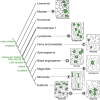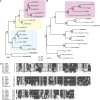Out of the mouths of plants: the molecular basis of the evolution and diversity of stomatal development
- PMID: 20179138
- PMCID: PMC2845417
- DOI: 10.1105/tpc.109.072777
Out of the mouths of plants: the molecular basis of the evolution and diversity of stomatal development
Abstract
Stomata are microscopic valves on the plant epidermis that played a critical role in the evolution of land plants. Studies in the model dicot Arabidopsis thaliana have identified key transcription factors and signaling pathways controlling stomatal patterning and differentiation. Three paralogous Arabidopsis basic helix-loop-helix proteins, SPEECHLESS (SPCH), MUTE, and FAMA, mediate sequential steps of cell-state transitions together with their heterodimeric partners SCREAM (SCRM) and SCRM2. Cell-cell signaling components, including putative ligands, putative receptors, and mitogen-activated protein kinase cascades, orient asymmetric cell divisions and prevent overproduction and clustering of stomata. The recent availability of genome sequence and reverse genetics tools for model monocots and basal land plants allows for the examination of the conservation of genes important in stomatal patterning and differentiation. Studies in grasses have revealed that divergence of SPCH-MUTE-FAMA predates the evolutionary split of monocots and dicots and that these proteins show conserved and novel roles in stomatal differentiation. By contrast, specific asymmetric cell divisions in Arabidopsis and grasses require unique molecular components. Molecular phylogenetic analysis implies potential conservation of signaling pathways and prototypical functions of the transcription factors specifying stomatal differentiation.
Figures






Similar articles
-
SCREAM/ICE1 and SCREAM2 specify three cell-state transitional steps leading to arabidopsis stomatal differentiation.Plant Cell. 2008 Jul;20(7):1775-85. doi: 10.1105/tpc.108.060848. Epub 2008 Jul 18. Plant Cell. 2008. PMID: 18641265 Free PMC article.
-
Evolution of the bHLH genes involved in stomatal development: implications for the expansion of developmental complexity of stomata in land plants.PLoS One. 2013 Nov 11;8(11):e78997. doi: 10.1371/journal.pone.0078997. eCollection 2013. PLoS One. 2013. PMID: 24244399 Free PMC article.
-
Orthologs of Arabidopsis thaliana stomatal bHLH genes and regulation of stomatal development in grasses.Development. 2009 Jul;136(13):2265-76. doi: 10.1242/dev.032938. Development. 2009. PMID: 19502487
-
Emerging roles of protein phosphorylation in regulation of stomatal development.J Plant Physiol. 2023 Jan;280:153882. doi: 10.1016/j.jplph.2022.153882. Epub 2022 Nov 26. J Plant Physiol. 2023. PMID: 36493667 Review.
-
Origins and Evolution of Stomatal Development.Plant Physiol. 2017 Jun;174(2):624-638. doi: 10.1104/pp.17.00183. Epub 2017 Mar 29. Plant Physiol. 2017. PMID: 28356502 Free PMC article. Review.
Cited by
-
AcoMYB4, an Ananas comosus L. MYB Transcription Factor, Functions in Osmotic Stress through Negative Regulation of ABA Signaling.Int J Mol Sci. 2020 Aug 10;21(16):5727. doi: 10.3390/ijms21165727. Int J Mol Sci. 2020. PMID: 32785037 Free PMC article.
-
An ancestral stomatal patterning module revealed in the non-vascular land plant Physcomitrella patens.Development. 2016 Sep 15;143(18):3306-14. doi: 10.1242/dev.135038. Epub 2016 Jul 12. Development. 2016. PMID: 27407102 Free PMC article.
-
How Does Stomatal Density and Residual Transpiration Contribute to Osmotic Stress Tolerance?Plants (Basel). 2023 Jan 21;12(3):494. doi: 10.3390/plants12030494. Plants (Basel). 2023. PMID: 36771579 Free PMC article. Review.
-
Loss or duplication of key regulatory genes coincides with environmental adaptation of the stomatal complex in Nymphaea colorata and Kalanchoe laxiflora.Hortic Res. 2018 Aug 1;5:42. doi: 10.1038/s41438-018-0048-8. eCollection 2018. Hortic Res. 2018. PMID: 30083357 Free PMC article.
-
Ultrastructure of stomatal development in early-divergent angiosperms reveals contrasting patterning and pre-patterning.Ann Bot. 2013 Oct;112(6):1031-43. doi: 10.1093/aob/mct169. Epub 2013 Aug 21. Ann Bot. 2013. PMID: 23969762 Free PMC article.
References
-
- Abrash E.B., Bergmann D.C. (2010). Regional specification of stomatal production by the putative ligand CHALLAH. Development 137: 447–455 - PubMed
-
- Apostolakos P., Panteris E., Galatis B. (1997). Microtubule and actin filament organization during stomatal morphogenesis in the fern Asplenium nidus. 1. Guard cell mother cell. Protoplasma 198: 93–106 - PubMed
-
- Bergmann D.C., Lukowitz W., Somerville C.R. (2004). Stomatal development and pattern controlled by a MAPKK kinase. Science 304: 1494–1497 - PubMed
-
- Bhave N.S., Veley K.M., Nadeau J.A., Lucas J.R., Bhave S.L., Sack F.D. (2009). TOO MANY MOUTHS promotes cell fate progression in stomatal development of Arabidopsis stems. Planta 229: 357–367 - PubMed
Publication types
MeSH terms
LinkOut - more resources
Full Text Sources
Molecular Biology Databases

